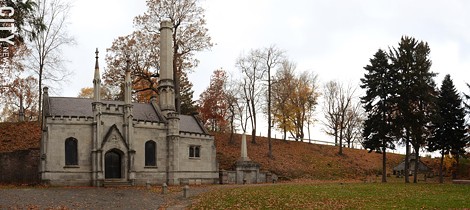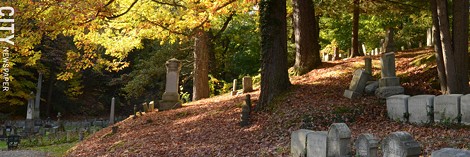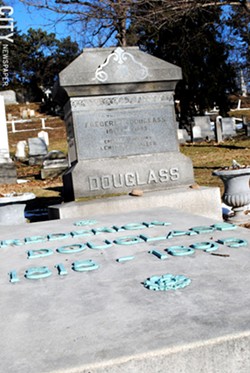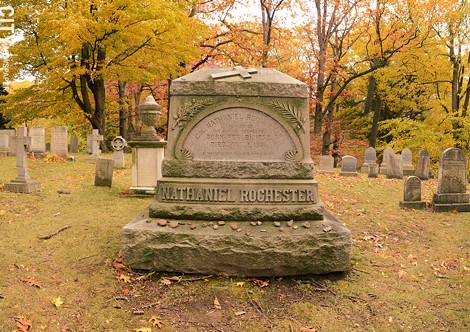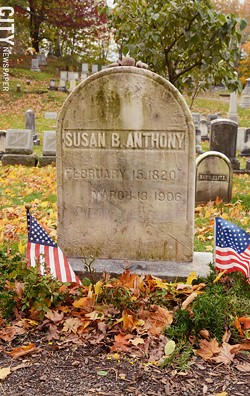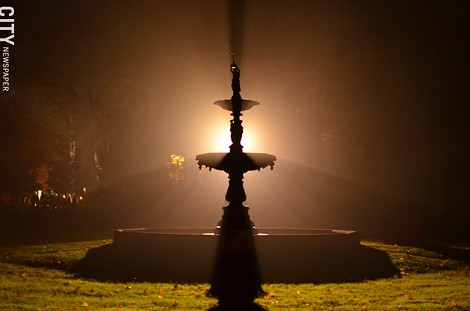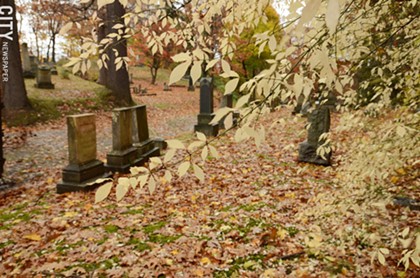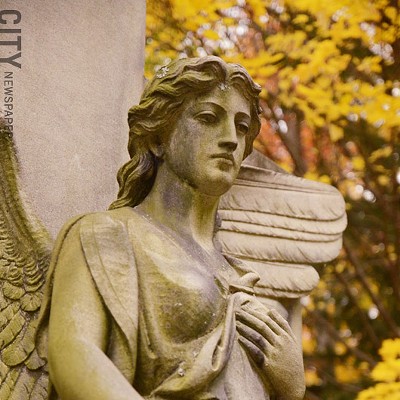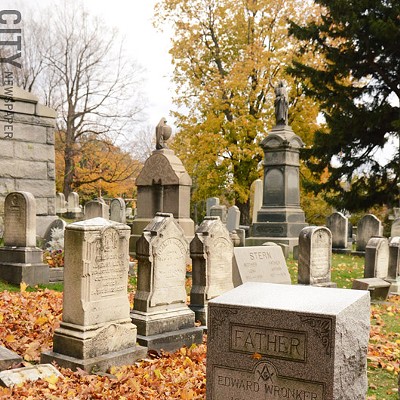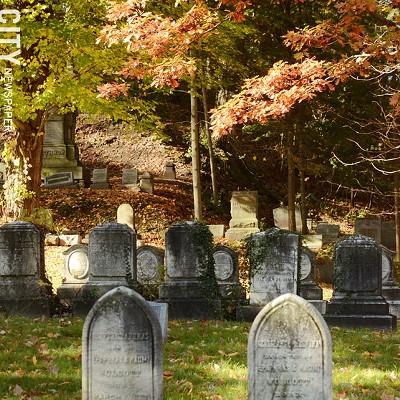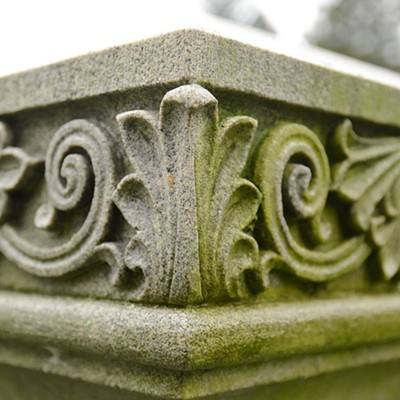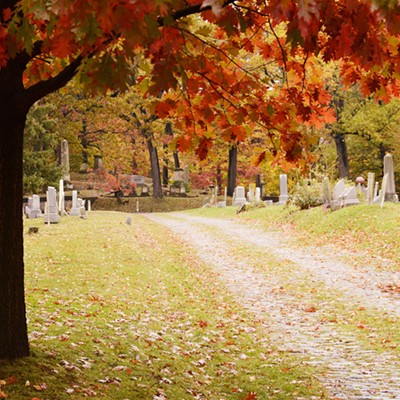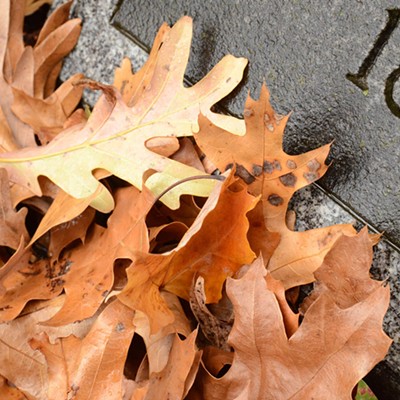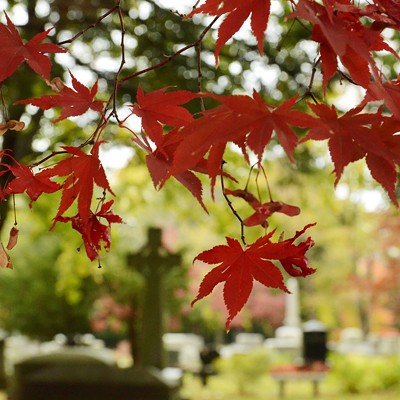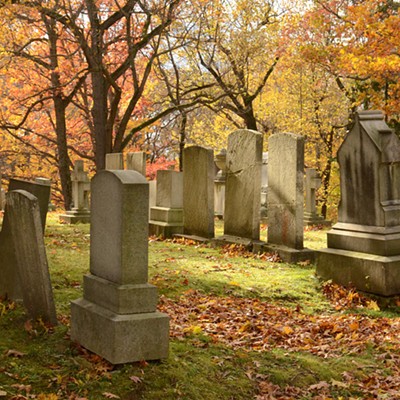Mount Hope Cemetery: A buried treasure
18 fascinating facts about the 175-year-old cemetery
By NICOLE MILANO[
{
"name": "500x250 Ad",
"insertPoint": "5",
"component": "15667920",
"parentWrapperClass": "",
"requiredCountToDisplay": "1"
}
]
Mount Hope Cemetery, dedicated in 1838, holds in its 196 acres more stories and mythology than many of us in the Flower City would guess. Over the past 175 years, the cemetery has become the final resting place for a variety of interesting people, and continues to serve as public burial grounds today — it is still owned and operated by the City of Rochester. Its dynamic landscape off Mount Hope Avenue is home to 82 mausoleums and many awe-inspiring architectural landmarks.
More recently in its storied history, a non-profit organization called the Friends of Mount Hope Cemetery has dedicated itself to helping to maintain the site. Founded in 1980 and currently headed by Marilyn Nolte, FOMH seeks to restore, preserve, and encourage public use and enjoyment of this cultural landmark. Its tour program, which runs from May through October, offers guided tours through both the south and north sections of the cemetery, as well as themed tours. (For more information visit fomh.org.)
Many know Mount Hope as the final resting place for notable Rochesterians like Susan B. Anthony, Frederick Douglass, and others. But countless other interesting facts and legends surround the burial grounds at Mount Hope. In celebration of the cemetery's 175th anniversary, which took place in October, Friends of Mount Hope Cemetery member Dennis Carr shared some of these lesser-known points with City. Below find some of the most interesting things you may not know about Mount Hope Cemetery.

Between 1832 and 1834, Rochester saw a significant cholera outbreak. Reportedly 110 people in a city of roughly 10,000 at the time were affected and died. This outbreak caused a sudden need for more burial space, and was one of the most significant factors in the opening of Mount Hope Cemetery. Initially, the cemetery was located a mile and a quarter beyond the city limits. Since then the city property line has expanded outward to include it.

Beyond the need for more burial space, the cemetery was also built to function as a public attraction. Rochester — one of America's first boomtowns — was at the heart of the Industrial Revolution. As the population rapidly expanded at the rate of nearly 300 people per day in the early 1830's, the City of Rochester built Mount Hope Cemetery to enhance the quality of life for people who settled here. The site became one of the first public park-like cemeteries in the United States, and people and families often visited it for leisure time and activities.

To enhance the cemetery's appeal as a public attraction, the graveyard was purposely built on a challenging landscape. Formed by glaciers during the last ice age, the location features hills, valleys, swamps, and heavily wooded areas. The cemetery itself is modeled after Mount Auburn Cemetery, a 170-acre graveyard in Cambridge, Massachusetts. Today, Mount Hope Cemetery continues to serve as more than just an interment site — it's a precious green space in an urban area that's been overtaken by concrete.

According to the most recent census information, the population of the City of Rochester stands at just more than 210,000. There are more than 350,000 people buried at Mount Hope Cemetery. Yes, that's right — more people are buried at the Cemetery than are currently living within Rochester city limits.

Most Rochesterians know that historical figures Susan B. Anthony and Frederick Douglass are buried at storied Mount Hope. However, they are just two of many notable people who have been laid to rest at the cemetery. For example, Ida Jane Anderson was a nurse at Rochester General Hospital when it was located on West Main Street. Anderson was a forward-thinking woman who was concerned with standardizing nursing practices. In 1903, she was appointed to a commission set up by the governor of New York State to identify licensing requirements for registered nurses. As a result, Anderson was issued the first nursing license in New York State.

Similarly, progressive public-health nurse Lillian Wald is also buried at Mount Hope. Wald was a contemporary of Jane Adams, who ran the Henry Street Settlement in New York City, which provided services to new immigrants and the poor. When the flu epidemic struck in 1918, Wald developed the concept of public-health nursing, and coined the term.

One of the most prominent millwrights in history, Robert Dalzell, is buried at Mount Hope. Dalzell came to Rochester in 1826, and built 18 flour mills between then and the 1850's. One of these mills, built in the 1830's, was the first in the world to incorporate a mechanical grain elevator. It was one of the most technologically advanced mills in the United States at the time, and helped Rochester earn its "Flour City" nickname.

Mount Hope is where our city's namesake, Nathaniel Rochester, is buried. Rochester traveled here from Maryland with his business partners in 1803, buying acres of land near Dansville. When Rochester and other settlers in that location began to be harassed by the British during the War of 1812, they moved north into the beginnings of what would become Rochester. On Rochester's family plot, it says in Latin, "If you would behold this monument, look around you." (This same inscription can be seen in St. Paul's Cathedral in London, referring to architect Sir Christopher Wren.)

While suffragist Susan B. Anthony herself is indeed buried at the cemetery, many others involved in her 1872 arrest and trial for illegal voting are also buried on the grounds. They include Elisha Keeney, the U.S. Marshall who arrested her; Henry Selden, her lawyer; Beverly Jones, the registrar who registered Susan B. to vote and was later jailed for it; and Commissioner William Storrs, to whom she was summoned when she was arrested. They are all buried quite close to her.

Beyond those related to our local history, some who are buried at the cemetery were involved in famous historical events. Stanley Fox was a gear salesman with Gleason Works who traveled to England on business. When Fox finished his job across the pond, he turned his thoughts homeward and boarded a little ship known as the Titanic. He died in the infamous disaster in April 1912, and his body was sent to Halifax to be identified and claimed by his family. A woman named Lydia Fox arrived to claim Stanley's body, and the casket was loaded onto a train to travel home with her. Shortly after the train's departure, a telegram was received from Cora Fox — Stanley Fox's wife — saying that Lydia was an impostor trying to commit insurance fraud. The body was recovered from the train at the next station without Lydia's knowledge, and returned to Rochester to be buried in the family plot.

As one might imagine, Mount Hope Cemetery has its share of creepy stories. One in particular stands out. Edward Crone was a student at Geneva's Hobart and William Smith Colleges in the early 1940's. He was studying to be an Episcopal priest, but enlisted in the army when World War II began. During his time in the service, Crone was taken prisoner by the Germans and held in Dresden in a building that had been a slaughterhouse — Slaughterhouse-Five. Imprisoned alongside Kurt Vonnegut, Crone became unhinged when the Germans prisoners were made to recover bodies after the Allies bombed Dresden. He stopped eating, and starved to death in the camp. His parents eventually recovered his body, and it was brought back to Rochester to be buried at Mount Hope Cemetery. Vonnegut used Crone as the model for Billy Pilgrim, the main character in his famous novel, "Slaughterhouse-Five."

Mount Hope's many tales do not all relate to pivotal movements in American history. Some are just good old-fashioned love stories. Harvey Foote and Margaret Peterson — a medical student and nurse during the Civil War, respectively — are buried there together. The two met in 1864 at St. Mary's Hospital, where they both worked. They quickly fell in love, and planned to marry. Soon after, a smallpox epidemic took hold. Foote decided to inoculate both himself and his lover. Sadly, the vaccine he used was contaminated and Peterson died. Foote was so distraught that his own health failed, and he too died shortly after. Both were in their early 20s when they died.

While the cemetery is the resting place for hundreds of thousands of unrelated individuals, several large organizations own plots of land within its borders. The University of Rochester purchased a large plot just two years after its founding in 1850 so that important members of the University community could be buried there. Among many others, UR presidents Martin Brewer Anderson — the University's first president — and Rush Rhees are buried at Mount Hope.

Though it's now known as the Hillside Children's Center, the Rochester Orphan Asylum was founded in 1837. The institution purchased a plot at Mount Hope Cemetery shortly after its founding. After half of its building burned down in a fire in 1901, the 29 children who died in the fire were buried at Mount Hope. Over the years, many children who died at the asylum were buried in the organization's plot at the cemetery.

Mount Hope Cemetery's cultural relevance extends beyond the bodies buried there. The cemetery features 82 mausoleums and is home to many significant architectural works, one of the most impressive being its Victorian Gothic gatehouse, located near the cemetery's north entrance on Mount Hope Avenue. The gatehouse at Mount Hope was constructed in 1874. Designed by architect Andrew Warner, the structure was intended to complement the Gothic chapel and Moorish gazebo in place on the grounds.

Indeed, many of the architectural landmarks at Mount Hope are what continue to draw visitors to the grounds. One of the most popular structures is the Florentine cast-iron fountain, which was built in 1875 to create a more impressive entrance at Mount Hope. Egyptian Revival was also an early architectural style at the cemetery. The obelisk, a symbol of the Egyptian sun god Ra, is prominent throughout the earlier-settled parts of the cemetery. The early popularity of this type of architecture in the United States is indicative of what the Friends of Mount Hope refer to as a sort of "national inferiority complex." At the time these landmarks were built, art from old-world cultures was considered high class. This is one of the reasons Greek and Roman influences can be seen prominently throughout the cemetery.

Want more creepiness? Of course you do. Carr tells the story of Rochester's first murder case: both the victim and the perpetrator are buried at Mount Hope, and in quite close proximity to each other in the old single-graves area near Elmwood Avenue. In 1837, 19-year-old Octavius Barron murdered William Lyman, a bookkeeper and manager at one of the flour mills. Barron learned that Lyman had been stealing money from the mill, and shot him in the back of the head in an attempt to steal the $5,000 Lyman had taken from the mill that night. He took Lyman's billfold out of his coat and ran to a nearby saloon. When looking through the billfold, however, he realized that it contained very little money. It was later revealed that Lyman had stored the money in a hat he was wearing, which rolled away when he was shot. Barron was eventually tried and hanged at Monroe County Jail.

One final murder tale from Carr should sate your appetite for cemetery legends. Marion Ira Stout, known to most as Ira, came to Rochester in 1857 after being released from a Pennsylvania jail. He learned that his sister Sarah was being beaten by her reportedly alcoholic husband, Charles Littles. Together, Ira and Sarah hatched a plan to murder Littles. One day, Ira told Littles that Sarah was going up to High Falls to meet a lover. When Littles pursued her there, Ira followed and smashed his skull with a hammer, eventually pushing his body over the falls. However, the body landed on a ledge. When Sarah and Ira climbed down to push it over, they injured themselves and left behind personal belongings that made it easy to connect them to the crime. They were tried, and convicted. Ira was eventually hung and buried at Mount Hope Cemetery.
To learn more about Mount Hope Cemetery, visit cityofrochester.gov/mounthope or the Friends of Mount Hope Cemetery at fomh.org.
Speaking of...
-

Michelle Daniels is all in on the Douglass family
Dec 23, 2021 -
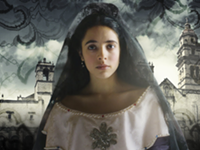
Biographical films and TV shows that bring historic leaders to life
Mar 1, 2021 -

Calendar preview: Going shopless
Nov 25, 2020 - More »
Latest in Culture
More by NICOLE MILANO
-

Five coffee drinks that are anything but usual
Dec 2, 2015 -

VOCAL | Celtic Woman
Jun 17, 2015 -

POP ROCK | Ed Sheeran
Jun 3, 2015 - More »

